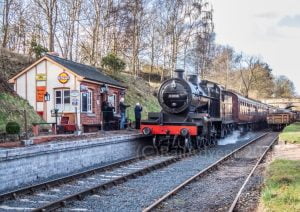This book illustrates the great contrasts in northern Lincolnshire’s railways over the last 40 years, from rural byways to industrial complexes with an equally varied range of passenger and freight trains.
Published in December 2022 by Key Publishing and written by Mike Wedgwood, this soft cover book is the publisher’s book No. 29 in its “Britain’s Railways” series. It measures around 24.3 cm x 17.7 cm, has 96 pages and 100 illustrations, and has a published price of £15.99 but is available from Amazon for £12.70.
The book has three chapters: The Scunthorpe Area; Around Barnetby: and Barton, Immingham, Grimsby and Cleethorpes. Together they illustrate what northern Lincolnshire means to railway enthusiasts – steel from Scunthorpe steelworks, oil from Lindsey oil refinery, and fish from Grimsby, not forgetting the impressive range of semaphore signals at Barnetby. Over the 40 years covered by this book fish trains from Grimsby have become a distant memory, but steel and oil trains are still part of the railway scene.
The relative remoteness of the area probably accounts for the large amount of steam-age railway infrastructure, stations and signalling that still exists and which the author has captured within this volume to provide a historical record of the area’s railways.
The book’s 180 photographs are each accompanied by extensive captions that as well as providing the basic, what, where, and when information about the images, includes additional information to provide a better understanding of the scene.
Giving no hint of Scunthorpe being a great steelmaking centre, the pages below show other cargos in the area, while Scunthorpe station gives no hint of the nearby steelworks.

The pages below are the only in the book that illustrate Scunthorpe’s steelmaking heritage. There is no mistaking the bottom left locomotive’s ancestry as a British Rail Class 20.

Each chapter includes a brief history of the lines in the area and the types of passenger and freight services likely to be seen. Until 2015, Barnetby was a great draw for enthusiasts from far and wide with its fine display of semaphore signals as in the photos below, now all swept away in the name of modernisation, as is the Class 45 diesel locomotive in the top photo. The Class 20 at the bottom right has also succumbed to the cutter’s torch, but is survived by a large number of its classmates.

The signal gantries visible in the top-left photo show clearly why Barnetby was such a photographic mecca for rail enthusiasts. Each of the trains shown below are typical of the block workings through the area.

Looking sadly run-down is New Holland station seen below. These photos can never be re-created as the station closed when the nearby Humber Bridge opened in 1981.

In the 40 years covered by this book the railway scene in northern Lincolnshire has changed dramatically, with fish trains from Grimsby now a distant memory but steel and oil trains are still part of the railway scene.
The author has included much of the steam-age railway infrastructure, stations, and signalling that until recently existed in the area, with photographs of New Holland Pier illustrating well how things once were.
Informative captions supplement the images to provide a better understanding of the trains and their workings. The author has also included a number of images of locomotives and trains not normally seen in the area.
An interesting book with many images that rekindle scenes of how railways used to be in the not-too-distant past. Each chapter’s introduction has just enough text to provide a good appreciation of the areas covered without getting lost in too much detail.
The book is available to purchase from Amazon and from Key Publishing.
We would like to thank Key Publishing for providing us with a copy of the book for review.





Responses